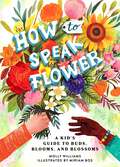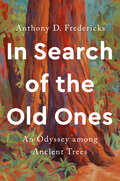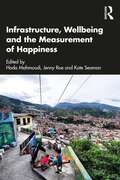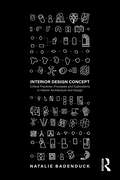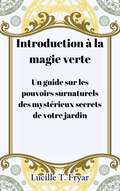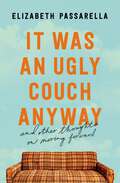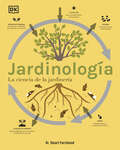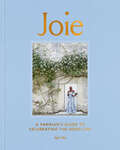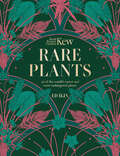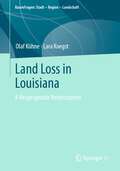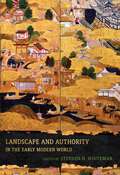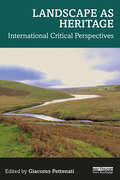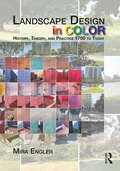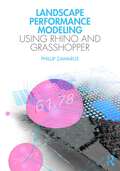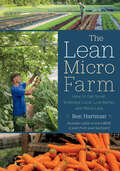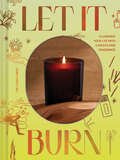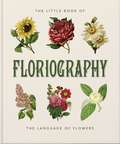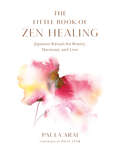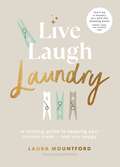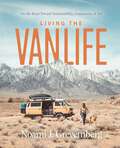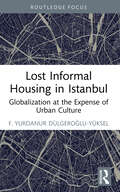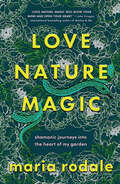- Table View
- List View
How to Speak Flower: A Kid's Guide to Buds, Blooms, and Blossoms
by Molly WilliamsA beautifully illustrated guide to the history and symbolism of flowers for every plant lover. Sunflowers are symbols of friendship. Gardenias represent secrets and mystery. Irises say, I trust you. Flowers bring color and beauty to the everyday world around us, but flowers aren&’t just pretty: Throughout history, they have been used to express ideas about ourselves and the people we care about. From asters to zinnias, from baby&’s breath to forget-me-nots, learn the magical, meaningful language of flowers with this magnificent guide to floriography. The secrets of every bloom and blossom are revealed … and with personalized quizzes and handy charts, you&’ll discover your own flower power!
Idée d'aménagement de piscine: Comment amenager et sécuriser votre piscine
by Owen JonesDescription du livre: J'espère que vous trouverez les informations utiles, utiles et profitables. Les informations contenues dans ce livre électronique sur la façon de tirer le meilleur parti de toutes les idées que vous pouvez avoir au sujet d'une piscine domestique sont organisées en 17 chapitres d'environ 500 à 600 mots chacun. J'espère qu'elles intéresseront ceux qui souhaitent créer une piscine domestique ou en tirer le meilleur parti. Il sera également utile à ceux qui envisagent de se lancer dans la création ou l'entretien de piscines. Il s'agit toutefois d'un guide pour débutants, mais j'espère qu'il suffira à vous intéresser ou à vous lancer. En prime, je vous autorise à utiliser le contenu de ce guide sur votre propre site web ou dans vos blogs et bulletins d'information, mais il est préférable que vous le réécriviez d'abord avec vos propres mots. Vous pouvez également diviser le livre et revendre les articles. En fait, le seul droit que vous n'avez pas est de revendre ou de donner le livre tel qu'il vous a été livré.
In Search of the Old Ones: An Odyssey among Ancient Trees
by Anthony D. FredericksAn extraordinary journey to visit the oldest trees in the United States that beautifully reveals the connection between humans and natural history— a perfect read for nature lovers and fans of The Hidden Life of Trees.Follow award-winning author Anthony D. Fredericks's adventures across the United States to uncover the remarkable secrets and lives of ancient trees. He introduces some of the oldest trees in the country using up-to-date research, interviews with scientists, captivating storytelling, and a contagious wonder for the natural world. Fredericks's visits to the trees turn readers into fellow travelers. Through firsthand accounts and scientific detail, these enduring trees come to life off the page.Each chapter begins with a time-travel story that immerses readers in Earth's past, as early as ~58,000 BCE, for a sweeping view of what was happening during human history when the ancient tree took root. It then zooms into present-day to investigate the tree in all its mature glory and the changed world around it.Some of the featured trees include: A 13,000-year-old Palmer's oak in California that survives by cloning itselfThe 1,200-year-old Seven Sisters Oak in Louisiana that has survived in the path of at least ten major hurricanes2,000-year-old redwoods (the tallest trees in the world) on the California coastThe 2,628 year old bald cypress in the Black River of North CarolinaMarvelously detailed and deeply passionate, In Search of the Old Ones will transform your perspective of the trees and forests around you.
Infrastructure, Wellbeing and the Measurement of Happiness
by Roe Jenny Seaman Kate Mahmoudi HodaThis book takes an interdisciplinary approach to our understanding of infrastructure, and it’s influence on happiness and wellbeing, by examining the concept from economic, human development, architectural, urban planning, psychological, and ethical points of view. Providing insights from both research and practice the volume discusses how to develop happier cities and improve urban infrastructure for the wellbeing of the whole population. The book puts forth the argument that it is only in understanding the true nature of infrastructure’s reach – how it connects, supports, and enlivens human beings – that we can truly begin to understand infrastructure’s possibilities. It connects infrastructure to that most elusive of human qualities – happiness – examining the way infrastructure is fundamentally tied to human values and human well-being. The book seeks to suggest novel approaches, identify outmoded undertakings, and define new possibilities in order to maximize infrastructure’s impact for all people – with a focus on diversity, inclusion and equity. In seeking to define infrastructure broadly and examine its possibilities systematically this book brings together theory and evidence from multiple disciplinary perspectives including, sociology, urban studies, architecture, economics, and public health in order to advance a startling claim – that our lives, and the lives of others, can be substantively improved by greater adhesion to the principles and practices of infrastructure design for happiness and wellbeing.
Interior Design Concept: Critical Practices, Processes and Explorations in Interior Architecture and Design
by Natalie BadenduckInterior Design Concept combines a comprehensive introduction to design concept, with a reflective examination upon the various ways it can be understood, harnessed, and implemented. Within interior architecture and design, the power of conceptual thinking to fuel creativity, innovation, and collaboration is evident in the use of design concept. Broadly accepted as an essential component in the design process, design concept is a notoriously elusive topic which has, until now, received little critical attention. This book offers a reevaluation of current academic ideas about design methodologies and the nature of inspiration, alongside brand-new data from an international research study to help clarify what creativity really means in the modern world. Topics addressed throughout this text will examine the functions and definitions of design concept, analyze how it may be identified and integrated within the design process, investigate from where ideas for design concepts can emerge and, lastly, consider how ideas about them might be communicated in various ways. This book offers students, educators, and practitioners a concise explanation of what design concept is, why it plays such an integral role in the design process, and how it is utilized by interior architects and designers.
Introduction à la magie verte: Un guide sur les pouvoirs surnaturels des mystérieux secrets de votre jardin
by Lucille T. FryarDémystifiez les pouvoirs cachés de la magie ancienne avec ce guide simple sur la magie verte. Toute sorcière peut insuffler dans sa vie de tous les jours la pratique et l'expérience du surnaturel grâce à la magie verte. Ce guide facile à comprendre vous introduit doucement dans le monde de la magie verte qui nous entoure et, en même temps, explique les anciennes pratiques sous des formes faciles à comprendre pour vous aider à saisir et à mettre en pratique les concepts de base de cette forme de magie. En tant que sorcière verte, vous devez être ouverte à la puissance de la nature qui coule à travers vous : tirez et exploitez les pouvoirs des herbes, des fleurs et des pierres pour vos sorts. Dans ce guide, vous apprendrez des méthodes simples pour cultiver vos plantes magiques et les types de plantes qui existent et comment faire ressortir la magie qu'elles renferment afin d'améliorer votre pratique. Grâce aux précieux conseils sur l'utilisation d'ingrédients magiques, vous prendrez plusieurs longueurs d'avance dans la prise en charge de votre pratique et forgerez un lien plus profond avec la nature. Accompagnez Lucille T. Fryar dans cet incroyable voyage et créez quelque chose de magique qui durera toujours ! Les épices et les herbes les plus omniprésentes dans votre jardin ou votre cuisine regorgent de pouvoirs qui dépassent votre imagination la plus folle et qui ne peuvent être libérés que par ceux et celles qui sont dotés des connaissances nécessaires pour y parvenir. À l'ère de la technologie de l'information, il faut s'engager à découvrir l'immense pouvoir que recèle la nature. Si vous souhaitez devenir une initiée, ce guide vous ouvrira le monde de la magie verte intemporelle. Ce livre est unique en son genre : Il fournit une forme d'aide qui n'est pas facilement disponible pour transformer les pouvoirs de la nature venant de l'extérieur dans votre espace person
It Was an Ugly Couch Anyway: And Other Thoughts on Moving Forward
by Elizabeth PassarellaA collection of refreshingly honest and hilarious essays from Southern Living columnist Elizabeth Passarella about navigating change--whether emotional or logistical--and staying sane during life's unexpected twists and turns.After Elizabeth Passarella and her husband finally decided that it was time to sell their two-bedroom apartment in Manhattan, she found herself wondering, Is there a proper technique for skinning a couch? The couch in question was a beloved hand-me-down from her father--who had recently passed away--and she was surprisingly reluctant to let the nine-foot, plaid, velour-covered piece of furniture go. So, out came the scissors. She kept the fabric and tossed the couch.We've all had to make decisions in our lives about what to keep and what to toss--habits, attitudes, friends, even homes. In this new collection of essays, Elizabeth explores the ups and downs of moving forward--both emotionally and logistically--with her welcome candor and sense of humor that readers have come to love. She enters into a remarkable (and strange) relationship with an elderly neighbor whose apartment she hopes to buy, examines her own stubborn stances on motherhood and therapy, and tries to come to terms with a family health crisis that brings more questions than answers. Along the way Elizabeth reminds readers that when they feel stuck or their load feels heavy, there is always light breaking in somewhere.It Was an Ugly Couch Anyway will make readers laugh, cry, and feel a little less alone as they navigate their own lives that are filled with uncertainty, change, and things beyond their control.
Jardinología (The Science of Gardening): La ciencia de la jardinería
by Dr. Stuart FarrimondUn libro de jardinería diferente que explica la ciencia detrás de la jardinería de forma visual y clara.¿El mundo de la botánica y la jardinería te parecen un misterio? Las guías de jardinería al uso tienden a dar gran cantidad de instrucciones y consejos, pero rara vez aportan explicaciones sobre el por qué. ¡No te preocupes! El Dr. Stuart Farromond arroja luz sobre todas esas preguntas que siempre te has hecho y te explica lo que sucede en tu jardín desde un enfoque científico.La guía botánica definitiva para entender los secretos de la horticultura y la floricultura como un profesional:Escrita con un lenguaje accesible y libre de tecnicismos en formato pregunta y respuesta. Con explicaciones claras, apoyadas por gráficos y esquemas para ilustrar los conceptos de forma visual.Estructurado en torno al ciclo de vida de un jardín, desde los primeros brotes hasta el momento de la poda.Explica los beneficios de la jardinería para la salud mental y el medio ambiente.Un práctico manual de jardinería con explicaciones y consejos avalados por la ciencia, que te ayudará a comprender mejor cómo se comportan las plantas, desmitificar creencias y descubrir las bases y avances de la horticultura moderna. ------------------------The only book to explain the science behind gardening practice in a simple and visually accessible way.The world of gardening can be a mystifying place, with so many instructions to follow and often little explanation as to why. Dr. Stuart Farromond casts his scientific eye over a typical year in the garden to answer all the horticultural questions you&’ve ever wanted the answer to. This great gardening book provides a shortcut to decades of gardening experience by explaining the science behind how a garden grows, featuring: An accessible guide structured around the life cycle of the garden, taking you from first shoots to pruning for renewal. An accessible Q &A format, with stats and infographics to bring the story to life, as well as long-held gardening myths are exploded by new science. Every way to greener fingers has an action point so that you can understand the science, apply your gardening practice, and enjoy a flourishing garden.From hands-on, practical advice, to an exploration of the mental health benefits of gardening, while also covering topics such as the positive impact gardening can have on the earth during a time of climate crisis in between, The Science of Gardening debunks myths and reveals the latest science only taught at horticultural college. As a passionate newcomer to gardening, daunted by the mountain of often conflicting advice in gardening manuals, Dr. Stu has set about testing the scientific basis of so much conventional wisdom and practice so you too can garden like a pro.
Joie: A Parisian's Guide to Celebrating the Good Life
by Ajiri AkiEmbrace the joy of Paris wherever you live with American expat Ajiri Aki, founder of the French lifestyle brand Madame de la Maison.&“More than being a terrific guide to the city, it&’s a thoroughly comprehensive guide to better living.&”—Chioma Nnadi, editor of VogueThe French are known for their joie de vivre—celebrating the simple things—a philosophy that tastemaker Ajiri Aki embraced all of her American life. As a child, she frequently tried to convince her Nigerian-Jamaican mother to pull out the fine china for everyday meals or when hosting friends. Her mother always said she was waiting for a special occasion, which sadly never came before she passed away when Ajiri was only twelve. Ajiri promised herself she would never hesitate to use her treasured pieces. When she moved to Paris, France, as an adult, she learned how central that idea is to French life, and she also began to absorb other essential lessons from her new friends: treat yourself to fresh flowers just because, take time to source the best baguette, and perhaps most importantly, enjoy être—just being.In this beautifully photographed volume of everything French, Ajiri shares what she&’s learned about living in Paris—from hosting the perfect apéro (happy hour) to lingering around town like a flâneur (loafer) to thrifting for antiques at the market. While exploring the prettiest cafes and shops, you&’ll be inspired to reclaim your right to leisure as the French have, so you, too, can savor the spontaneous, joyful moments that happen every day.
Kew - Rare Plants: The world's unusual and endangered plants
by Ed Ikin Royal Botanic Kew"Some plants are inherently rare, while others become rare through our actions."Rare Plants explores what makes the world's most uncommon plants so exceptional, and by what means they have become so scarce. From highlands to jungles, many of our most extraordinary plants are vanishing at shocking rates, and this exquisitely illustrated book explores 40 of these mysterious species.Featuring stunning archive images and expert insight from the Royal Botanical Gardens, Kew, Rare Plants explores both the beauty and necessity of our endangered plant life.
Kew - Rare Plants: The world's unusual and endangered plants
by Ed Ikin Royal Botanic Kew"Some plants are inherently rare, while others become rare through our actions."Rare Plants explores what makes the world's most uncommon plants so exceptional, and by what means they have become so scarce. From highlands to jungles, many of our most extraordinary plants are vanishing at shocking rates, and this exquisitely illustrated book explores 40 of these mysterious species.Featuring stunning archive images and expert insight from the Royal Botanical Gardens, Kew, Rare Plants explores both the beauty and necessity of our endangered plant life.
Land Loss in Louisiana: A Neopragmatic Redescription (RaumFragen: Stadt – Region – Landschaft)
by Olaf Kühne Lara KoegstThis book is oriented on testing and developing the neopragmatic approach of horizontal geographies, in which we follow approaches of natural sciences, social sciences, and cultural studies. Regional focus is thereby put on a rapidly changing elemental space and its social representations, characterized by unstable and not well-defined hybridities: coastal Louisiana. This region is highly dynamic: the Mississippi River in particular, with its extensive sediments, has shifted the coastal fringe of present-day Louisiana into the Gulf of Mexico. This land gain is contrasted by natural processes, but also by processes resultant of human intervention which cause marine encroachment. A complex interplay of different aspects is directly and indirectly leading to coastal land loss which makes the question of how to describe emerging hybrid spaces virulent and highlights the limits of a positivist understanding of boundaries that is also physically geographical. In the neopragmatic tradition, positivist research findings will be framed in social constructivist terms and supplemented by phenomenological approaches to Louisiana's coastal space, thus suggesting the need for and potentials of horizontal geographic integration of different theoretical and methodological approaches as well as researcher perspectives and data bases.
Landscape and Authority in the Early Modern World (Penn Studies in Landscape Architecture)
by John Dixon HuntCourts and societies across the early modern Eurasian world were fundamentally transformed by the physical, technological, and conceptual developments of their era. Evolving forms of communication, greatly expanded mobility, the spread of scientific knowledge, and the emergence of an increasingly integrated global economy all affected how states articulated and projected visions of authority into societies that, in turn, perceived and responded to these visions in often contrasting terms. Landscape both reflected and served as a vehicle for these transformations, as the relationship between the land and its imagination and consumption became a fruitful site for the negotiation of imperial identities within and beyond the precincts of the court.In Landscape and Authority in the Early Modern World, contributors explore the role of landscape in the articulation and expression of imperial identity and the mediation of relationships between the court and its many audiences in the early modern world. Nine studies focused on the geographical areas of East and South Asia, the Islamic world, and Europe illuminate how early modern courts and societies shaped, and were shaped by, the landscape, including both physical sites, such as gardens, palaces, cities, and hunting parks, and conceptual ones, such as those of frontiers, idealized polities, and the cosmos.The collected essays expand the meaning and potential of landscape as a communicative medium in this period by putting an array of forms and subjects in dialogue with one another, including not only unique expressions, such as gardens, paintings, and manuscripts, but also the products of rapidly developing commercial technologies of reproduction, especially print. The volume invites a deeper and more nuanced understanding of the complexity with which early modern states constructed and deployed different modes of landscape for different audiences and environments.Contributors: Robert Batchelor, Seyed Mohammad Ali Emrani, John Finlay, Caroline Fowler, Katrina Grant, Finola O’Kane, Anton Schweizer, Larry Silver, Stephen H. Whiteman.
Landscape as Heritage: International Critical Perspectives
by Giacomo PettenatiThis edited book provides a broad collection of current critical reflections on heritage-making processes involving landscapes, positioning itself at the intersection of landscape and heritage studies. Featuring an international range of contributions from researchers, academics, activists, and professionals, the book aims to bridge the gap between research and practice and to nourish an interdisciplinary debate spanning the fields of geography, anthropology, landscape and heritage studies, planning, conservation, and ecology. It provokes critical enquiry about the challenges between heritage-making processes and global issues, such as sustainability, economic inequalities, social cohesion, and conflict, involving voices and perspectives from different regions of the world. Case studies in Italy, Portugal, Spain, Slovenia, the Netherlands, Turkey, the UK, Columbia, Brazil, New Zealand, and Afghanistan highlight different approaches, values, and models of governance. This interdisciplinary book will appeal to researchers, academics, practitioners, and every landscape citizen interested in heritage studies, cultural landscapes, conservation, geography, and planning.
Landscape Design in Color: History, Theory, and Practice 1750 to Today
by Mira EnglerArchitects, landscape architects and urban designers experiment with color and lighting effects in their daily professional practice. Over the past decade, there has been a reinvigorated discussion on color within architectural and cultural studies. Yet, scholarly enquiry within landscape architecture has been minimal despite its important role in landscape design. This book posits that though color and lighting effects appear natural, fleeting, and difficult to comprehend, the sensory palette of built landscapes and gardens has been carefully constructed to shape our experience and evoke meaning and place character. Landscape Design in Color: History, Theory, and Practice 1750 to Today is an inquiry into the themes, theories, and debates on color and its impact on practice in Western landscape architecture over the past three centuries. Divided into three key periods, each chapter in the book looks at the use of color in the written and built work of key prominent designers. The book investigates thematic juxtapositions such as: natural and artificial; color and line; design and draftsmanship; sensation and concept; imitation and translation; deception and display; and decoration and structure, and how these have appeared, faded, disappeared, and reappeared throughout the ages. Richly designed and illustrated in full color throughout, including color palettes, this book is a must-have resource for students, scholars, and design professionals in landscape architecture and its allied disciplines.
Landscape Performance Modeling Using Rhino and Grasshopper
by Phillip ZawarusThis is a guidebook for landscape architects to learn the fundamental practices and use of the computational software Rhino 3D and the plugin Grasshopper for parametric modeling, landscape inventory, and performative analysis. This process visually connects intangible and abstract information with physical and spatial relationships to signify the impact ecological, climate, and cultural factors have on landscape performance and decision making. Each chapter begins with a summary of the performance method and its application in different projects, outlining the expected goals from industry standard equations and operations. Chapters cover parametric modeling scripts to measure ecosystem services of stormwater management, erosion control, tree benefits, outdoor comfort, accessibility, and many others. Using photographs, tables, and parametric scripts to create qualitative and quantitative representations of landscape performance and ecosystem services, readers will learn to communicate the impact and significance of their outputs. This book will be beneficial to educators, students, and professionals interested in using computational modeling as a performance assessment and graphic visualization tool.
The Lean Micro Farm: How to Get Small, Embrace Local, Live Better, and Work Less
by Ben Hartman“Ben Hartman is a true innovator for the small farm.”—Curtis Stone, author of The Urban Farmer It’s time to think big about small farms. Award-winning author and “green leader” (Grist) Ben Hartman shares practical how-to tips, personal stories, and surprising examples of cutting-edge farmers and innovators around the world to show us how. In the early 1970s, US Agriculture Secretary Earl Butz infamously commanded farmers to “get big or get out.” In The Lean Micro Farm, author Ben Hartman rejects that disastrous suggestion and instead takes up the charge of the late agrarian thinker Gene Logsdon: “Get small and stay in.” Taking inspiration from the groundbreaking ideas of E. F. Schumacher and Mahatma Gandhi, The Lean Micro Farm shows how small, hyperlocal farms can be both ecologically and economically superior to industrial-scale operations geared toward export and commodity markets. The Lean Micro Farm details the author’s remarkable journey to downsize his farm from one acre to a third of an acre in an effort to prioritize family and community over work, all without taking a pay cut. In addition, Hartman profiles six innovative farmers from across the globe who embody this “get small” mindset. These pioneering farmers show all of us a path toward resilience in the face of supply chain disruption, globalization, and climate change. They model a gentler, more ecological approach to farming that produces less waste and uses less plastic, petroleum, and fertilizer. Like his previous two books, The Lean Farm and The Lean Farm Guide to Growing Vegetables, Hartman’s The Lean Micro Farm doesn’t just explain why smaller is better, it shows readers exactly how it can be done with step-by-step guides on how to turn a profit from a tiny, but productive, parcel of farmland. Readers will find not just philosophical justifications for a minimalist approach to agriculture but also actionable information for starting your own profitable micro farm, including: A description of the “deep mulch” method for building fertility Instructions on two-step bed flipping to increase production on a small footprint A guide for choosing essential tools and technologies “with a human face” An easy-to-follow process for making your micro farm lean and efficient A detailed plan for selling $20,000 worth of produce from your backyard It’s time, Hartman makes clear, to pivot to a new kind of farming—one that builds upon ancestral knowledge, nourishes communities, and puts human joy, not technology, at its center. “Hartman has revolutionized his methods, cut down his work hours dramatically, and shrunk the size of his farm, all while making a better income.”—Civil Eats
Let It Burn: Illuminate Your Life with Candles and Fragrance
by Sir Candle ManA guide to loving candles, living with candles, and using the magic of fragrance to help create beautiful spaces in your life.Discover the world of candles with Sir Candle Man, the preeminent candle-care expert who knows all the right ways to set a mood through the exquisite combination of wax and fragrance. Bougie means "candle" in French, which is quite fitting: Lighting a candle is like a ritual, a moment to treat yourself.Scent is powerful: for memory, for comfort, and for making your space your own. Whether you want to relax, have fun with friends at a dinner party, or use the right fragrance to focus and get some work done, scented candles are the easiest way to change a vibe instantly.With informative and inspiring guidance on buying and gifting candles, building your collection, decorating with candles, and adding them to your wellness rituals, Let It Burn will teach you how to light up your life with the magic of fragrance and flame.Get lit. Stay lit. You deserve it.EVERYONE LOVES CANDLES: Candles, especially high-end, beautifully designed candles (and their corresponding accessories), are not just for decor; they're a whole vibe. There's no better or more affordable way to change up the mood of your space, and this book shows you how. THE PERFECT LIT GIFT: Pair this book with a single candle, candle set, candle holder, wick trimmer, snuffer, a beautiful box of matches, or a lighter to create an irresistible gift set.THE FIRST CANDLE BOOK OF ITS KIND: While there are books about candle making, this is the first to explore the powerful connection between candles and self-care.Perfect for:Entertaining enthusiastsDIY decorators and anyone interested in scent or experiential decorSelf-purchase or gift for anyone seeking to explore self-care rituals and personal wellnessAnyone starting out in a new home or apartmentA great gift for grads, newlyweds, and hosts or hostessesBirthday, Valentine's Day, anniversary, or get-well gift for women or men
The Little Book of Floriography: The Secret Language of Flowers (The\little Book Of... Ser.)
by Orange Hippo!Revealing a world of secret messages contained within a single petal.Floriography – the language of flowers – is the ancient art of encoding hidden messages in the type, colour and arrangement of plants, allowing individuals to express emotions and sentiments that they may not be able to articulate through words.Featuring 100 of the most popular and available blooms from around the world, this beautifully illustrated gift book gives the botanical name for each plant, a description of its significance and place in folklore, and the story behind its meaning. It also reveals how floral symbolism has been used over the centuries in literature and art, from Hamlet's Ophelia handing out rosemary 'for remembrance' and pansies 'for thoughts', to Oscar Wilde urging his friends to wear green carnations as a subtle code for homosexuality. The idea that flowers have secret meanings would have been well understood by contemporary audiences – and we are seeing a revival of the practice today.From mimosa – which signifies chastity because its leaves close when touched – to the varied messages encoded within different colours of geraniums, Floriography offers a creative way to convey feelings and can add an extra layer of beauty and significance to a gift of flowers.The flowers in Kate Middleton's wedding bouquet signified love, happiness, gallantry and fidelity.If someone sends you a bouquet of hydrangea and lobelia, beware: they stand for heartlessness and malevolence.
The Little Book of Floriography: The Secret Language of Flowers (The\little Book Of... Ser.)
by Orange Hippo!Revealing a world of secret messages contained within a single petal.Floriography – the language of flowers – is the ancient art of encoding hidden messages in the type, colour and arrangement of plants, allowing individuals to express emotions and sentiments that they may not be able to articulate through words.Featuring 100 of the most popular and available blooms from around the world, this beautifully illustrated gift book gives the botanical name for each plant, a description of its significance and place in folklore, and the story behind its meaning. It also reveals how floral symbolism has been used over the centuries in literature and art, from Hamlet's Ophelia handing out rosemary 'for remembrance' and pansies 'for thoughts', to Oscar Wilde urging his friends to wear green carnations as a subtle code for homosexuality. The idea that flowers have secret meanings would have been well understood by contemporary audiences – and we are seeing a revival of the practice today.From mimosa – which signifies chastity because its leaves close when touched – to the varied messages encoded within different colours of geraniums, Floriography offers a creative way to convey feelings and can add an extra layer of beauty and significance to a gift of flowers.The flowers in Kate Middleton's wedding bouquet signified love, happiness, gallantry and fidelity.If someone sends you a bouquet of hydrangea and lobelia, beware: they stand for heartlessness and malevolence.
The Little Book of Zen Healing: Japanese Rituals for Beauty, Harmony, and Love
by Paula AraiAccessible and adaptable Japanese Buddhist rituals to infuse your life with purpose, healing, and gratitude when you need it most.How do we make and sustain meaning amidst the messy conditions of daily life? Personalized rituals can help us blossom like lotuses right in the mud of the present. On a pilgrimage she began after her mother&’s death, author Paula Arai encountered numerous Japanese Buddhists who taught her the remarkable power of ritual to heal—practices you can adapt to your own cultural and personal circumstances. Applying principles of Zen practice, she offers stories and insights that illuminate how to nourish and reap a healing bounty of connection, joy, and compassion. Examples include how to: Relate to a late loved one as a &“personal Buddha&” who supports you Create a home altar to serve as a safe space to be vulnerable, face intense emotions, and experience a depth of warm gratitude that melts fear and anger Engage in daily tasks with attentiveness, intention, and creativity such that they become opportunities for body-mind integration Develop family rituals to celebrate relationship and mark transition Approach illness and grief with a purposeful sense of connection to life-and-death in its wholeness Like Marie Kondo's Shinto principles for decluttering, Paula Arai uses rituals influenced by Japanese Zen for personal and relation nourishment and spiritual healing.
Live, Laugh, Laundry: A calming guide to keeping your clothes clean – and you happy
by Laura MountfordIn this essential guide to all things laundry, much-loved online cleaning expert Laura Mountford shows us how we can all do our laundry better, so that we feel happier and calmer every day. With self-care tips to incorporate into your routine and beautiful line drawings throughout, in this book you'll find:- A guide to must-have products & laundry symbols- Instructions on how to wash any clothing/fabric- Troubleshooting for common mistakes- Tips for being more eco-friendly & saving money- and much more!Helping you feel less overwhelmed and full of new ideas that will make you excited to put on your next wash, Live Laugh Laundry is the soothing and useful guide we all need to the life-changing magic of laundry.'My laundry routine has helped me hugely on difficult days - I'd love for it to do the same for you.'
Living the Vanlife: On the Road Toward Sustainability, Community, and Joy
by Noami GrevembergDiscover what it&’s really like to live and work full-time on the road in a camper van from eco-vanlifer and founder of the Diversify Vanlife movement, Noami Grevemberg.Feeling dissatisfied with her office job and her &“stationary home,&” in 2016 Noami Grevemberg took a bold step. She quit her job, sold her belongings, and set out in her 1985 VW Vanagon to pursue a life of simplicity and travel with her husband and German Shepherd by her side. In her years living fulltime on the road, Noami has become an expert in the many aspects of vanlife. In her book Living the Vanlife, she digs into all aspects of the lifestyle, from getting over the uncomfortable feeling of uncertainty, to creating a sustainable, thriving life of adventure and a captivating path of choosing whatever it is you truly want for yourself. Through personal stories and actionable advice, Noami candidly and compassionately demonstrates for readers that challenging the "status quo&” means taking bold steps, venturing out of your comfort zone, taking risks, and living intentionally. As a Trinidadian immigrant, Noami also takes a practical look at life on the road as a BIPOC navigating many intersections and speaks to topics like converting a van to fit your specific needs, budgeting for vanlife, finding employment, staying safe, and building a supportive community on the road. Featuring evocative full-color photographs of Noami&’s journey, Living the Vanlife is an inclusive and celebratory look at an increasingly popular way of life.
Lost Informal Housing in Istanbul: Globalization at the Expense of Urban Culture
by F. Yurdanur Dulgeroglu-YukselThe dynamics of globalization brought a radical change in megacities and tensions between the stakeholders and dwellers against top-down urban renewal policies. This unique book provides a worldview of multi-stakeholders in the urban housing market. With a longitudinal research approach, it paves the way for interdisciplinary researchers to critically assess the urban renewal projects and update such studies. The urban renewal processes are implemented without participation, and the book highlights field-based information for policymakers. The reader will find, with the information provided from the field, why participation is necessary for a sustainable urban development, why there are different types of urbanizations, and how it works under different conditions. Better understanding of the challenges of urban renewal processes in the world cities is intended with the focus on the changing informal settlements. Istanbul is a megacity, housing more than half of its dwellers in informal settlements. After many decades of self-upgrading and silently communicating with the local authorities, the informal sector had become adapted and maintained its living spaces. Unexpectedly, the end of the first decade of the 21st century marked a radical urban land valuation and international investments. Top-down interventions started with naming Istanbul the 2010 European Capital of Culture. Then came the Law of Urban Transformation, which meant the fast decline of squatter housing and the speedy loss of its cultural value of the mahalle spirit, place identity. The book will raise curiosity on why the time has come to change the perspectives about the informal urban sector.
Love, Nature, Magic: Shamanic Journeys into the Heart of My Garden
by Maria RodaleJoin bestselling author, activist, and garden expert Maria Rodale on her shamanic journeys as she reflects on her surprising conversations with the spirits of the familiar plants and animals around us—and the knowledge they share with us. In Love, Nature, Magic, organic advocate and former CEO of a global health and wellness company Maria Rodale combines her love of nature and gardening with her experience in shamanic journeying, embarking on an epic adventure to learn from plants, animals, and insects—including some of the most misunderstood beings in nature. Maria asks them their purpose and listens as they show and declare what they want us humans to know. From Thistles to Snakes, Poison Ivy to Mosquitoes, these nature beings convey messages that are relevant to every human, showing us how to live in balance and harmony on this Earth. Through journeys filled with surprises, humor, and foibles, follow Maria’s evolution from being annoyed with to accepting—and even falling in love with—our most difficult neighbors (including human ones). Along the way, she tells her own story of how she learned about shamanic journeying and its near-universal manifestation in traditional cultures worldwide. She describes what her experiences of shamanic journeying are like—simply, honestly, and with a touch of irreverence. Maria’s journeys include conversations with: Mugwort • Vulture • Bat • Rabbit • Lanternfly • Lightning Bug • Osage Orange • Deer • Paper Wasp • Dandelion • Tick • Groundhog • Milkweed • And more! Throughout, Rodale shares an essential truth that resonates across her shamanic explorations: We first must heal our own hearts, for only then can we truly love others and begin to heal planet Earth.
